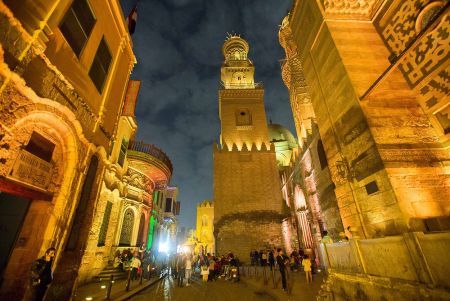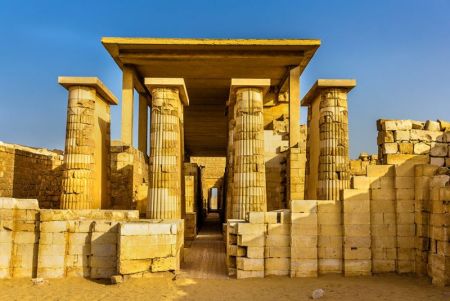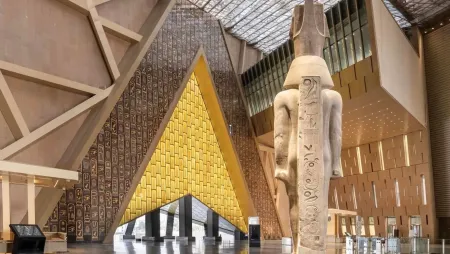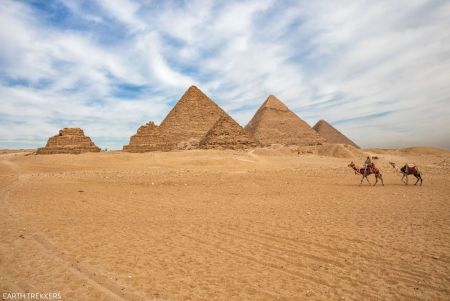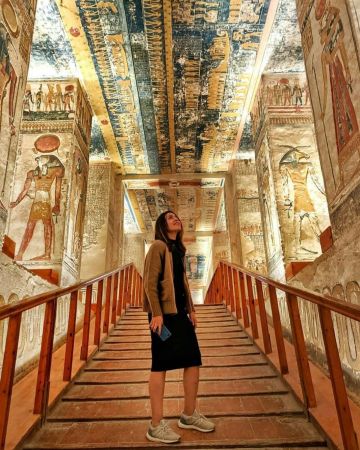Explore the charm of El Moez Street Cairo on an unforgettable Islamic Cairo walking tour. Discover ancient mosques, vibrant bazaars, and rich Egyptian heritage.
Djoser's Step Pyramid in Sakkara is undoubtedly one of Egypt's most iconic monuments, and rightfully so. This magnificent structure marks a pivotal moment in ancient Egyptian history, as it set the stage for the architectural marvels that followed. In this comprehensive article, we'll delve into the fascinating details of Djoser's Step Pyramid, exploring its historical significance, architectural innovations, and the secrets that still lie beneath its layers.

The Dawn of a New Era: Djoser's Step Pyramid in Context
The Step Pyramid was constructed during Egypt's Third Dynasty, specifically for Pharaoh Djoser. As the first pyramid ever built in Egypt, it may not be as famous or visually impressive as the Giza Pyramids, but this monument holds immense historical importance. The Step Pyramid signifies the first large-scale cut-stone structure in the world, predating other renowned pyramids by several centuries.
The Architectural Genesis
Djoser's Step Pyramid represents the evolution from the traditional mastaba, a flat rectangular tomb structure, to the more imposing pyramidal form. By stacking multiple mastabas atop one another, Djoser's builders created a commanding monument that would eventually inspire the smooth-sided pyramids of Giza and Dahshur.
A Monumental Achievement
Standing 203 feet tall, the Step Pyramid consists of six distinct layers or steps, each decreasing in size as they ascend. This innovative design paved the way for the pyramids that have made Ancient Egypt famous throughout history.
The Mastermind Behind the Structure: Imhotep
Imhotep, the architect responsible for this groundbreaking design, was a multi-talented figure in ancient Egyptian history. As a physician, priest, and chief advisor to Pharaoh Djoser, his genius manifested in various fields. In recognition of his architectural prowess, Imhotep was later deified, making him the only non-royal Egyptian to achieve such an honor.
Innovations in Construction Techniques
Imhotep's design of the Step Pyramid showcased several novel construction techniques. Instead of using mud-bricks, which were the standard building material at the time, he opted for limestone blocks. This choice allowed for a more durable and visually stunning result, setting a new standard for future pyramid construction.

The Birth of Monumental Architecture
The Step Pyramid also marked the beginning of monumental architecture in ancient Egypt. As an enduring symbol of the pharaoh's power, this structure inspired future generations to create even more impressive architectural feats.
The Sacred Complex Surrounding the Step Pyramid
The Step Pyramid is not a standalone structure but is part of a larger sacred complex that encompasses approximately 40 acres. This complex, designed to serve as Djoser's eternal resting place, consists of various temples, courtyards, and chapels.
The Enclosure Wall
The enclosure wall, which surrounds the Step Pyramid complex, is an impressive structure in itself. Standing 34 feet high, it features a series of bastions and recesses that mimic a royal palace's façade. This wall, constructed with more than 10,000 limestone blocks, is a testament to the architectural prowess of Djoser's reign.
The Heb-Sed Court
The Heb-Sed court, located within the complex, is a large, open space designed to host the pharaoh's Heb-Sed festival. This ceremony, held every 30 years, aimed to rejuvenate the pharaoh and reaffirm his divine connection. The court's layout, with its raised platforms and intricate reliefs, reflects the significance of this sacred event.
The Southern Tomb
Another noteworthy structure within the complex is the Southern Tomb. Although the exact purpose of this tomb remains a mystery, it is believed to have held the pharaoh's ka, or life force. The Southern Tomb's subterranean chambers are adorned with intricate carvings and blue faience tiles, showcasing the artistic talents of Djoser's time.
The Step Pyramid's Evolution: Uncovering the Building Process
The Step Pyramid underwent several design changes throughout its construction. Initially, Djoser's tomb began as a square mastaba, but Imhotep's ambitious vision led to the development of the stepped structure we see today.
The Stages of Transformation
The Step Pyramid's evolution can be broken down into several stages:
- The initial square mastaba, built over the burial chamber.
- The decision to expand the mastaba into a four-stepped structure.
- The addition of two more steps, resulting in the final six-stepped pyramid.
This transformation illustrates the creative process behind the monumental design and highlights the architectural innovations of Djoser's era.
The Burial Chamber: A Journey into the Afterlife
Beneath the Step Pyramid lies Djoser's burial chamber, a complex labyrinth of tunnels and chambers designed to protect the pharaoh's remains and ensure his safe passage to the afterlife.
The Descending Passage
The burial chamber is accessed via a descending passage, which is sealed with a massive granite plug. This plug, weighing nearly 20 tons, was intended to deter tomb robbers and preserve the sanctity of Djoser's resting place.
The Gallery of Offerings
Beyond the descending passage lies the gallery of offerings, a long corridor adorned with carvings of food and drink. These offerings were meant to sustain Djoser's ka as it journeyed through the afterlife.
The Subterranean Chambers
A series of subterranean chambers surround the burial chamber, housing the remains of Djoser's family members and high-ranking officials. These chambers are intricately decorated with carvings and inscriptions, providing valuable insights into the religious beliefs and customs of Djoser's time.
The Step Pyramid's Legacy: Inspiring Future Generations
The Step Pyramid's innovative design and construction techniques inspired future generations of architects and builders, who would go on to create the iconic pyramids of Giza and Dahshur.
The Meidum Pyramid: An Intermediate Step
The Meidum Pyramid, built during the reign of Pharaoh Sneferu, represents an intermediate step between the Step Pyramid and the smooth-sided pyramids. Its design, featuring a seven-stepped core encased in a smooth outer layer, demonstrates the ongoing evolution of pyramid construction.
The Bent Pyramid: A Learning Curve
The Bent Pyramid, also built by Sneferu, is another example of the ongoing experimentation in pyramid design. Its unique shape, with a change in slope mid-way up the structure, is believed to have resulted from structural issues encountered during its construction. This experience undoubtedly informed the design of future pyramids.

The Great Pyramid of Giza: The Culmination of Architectural Innovation
The Great Pyramid of Giza, built by Pharaoh Khufu, stands as the culmination of architectural innovation inspired by Djoser's Step Pyramid. This colossal monument, with its smooth, perfectly aligned sides, showcases the advanced engineering skills and ingenuity of ancient Egyptian builders.
The Ongoing Mysteries of Djoser's Step Pyramid
Despite extensive research and excavation, the Step Pyramid still holds many secrets yet to be uncovered. Archaeologists continue to investigate the complex, hoping to gain further insights into the lives and beliefs of those who built this iconic monument.
The Hidden Tunnels
Recent discoveries have revealed a network of hidden tunnels beneath the Step Pyramid. These tunnels, which connect the pyramid with other structures within the complex, were likely used for ceremonial purposes and may hold clues to the religious practices of Djoser's time.
The Unexplored Chambers
Several chambers within the Step Pyramid remain unexplored, as their fragile state and potential booby traps pose significant risks to archaeologists. However, advancements in technology may eventually allow for the safe investigation of these spaces, revealing more about the pyramid's construction and the lives of those entombed within.
The Step Pyramid: An Enduring Icon of Ancient Egyptian Architecture
Djoser's Step Pyramid, with its innovative design and monumental scale, stands as an enduring testament to the architectural prowess of ancient Egypt. As the first pyramid in history, it set the stage for the iconic structures that have come to define this remarkable civilization.
A Symbol of Power and Eternity
The Step Pyramid not only served as a tomb for Pharaoh Djoser but also as a symbol of his power and eternal legacy. The monument's imposing form and intricate design reflect the divine status of the pharaoh, ensuring his place in history for generations to come.
A Lasting Influence
Djoser's Step Pyramid continues to inspire awe and admiration in those who visit this ancient monument. Its innovative design and the ingenuity of its builders remain a source of fascination for scholars and enthusiasts alike, as they seek to unravel the mysteries of this iconic structure.
In conclusion, Djoser's Step Pyramid in Sakkara is a monument that revolutionized ancient Egyptian architecture and laid the foundation for the iconic pyramids that followed it. As an enduring icon of this fascinating civilization, the Step Pyramid holds a wealth of historical, architectural, and cultural significance that continues to captivate the imagination and inspire admiration from people across the globe.
.jpg)


